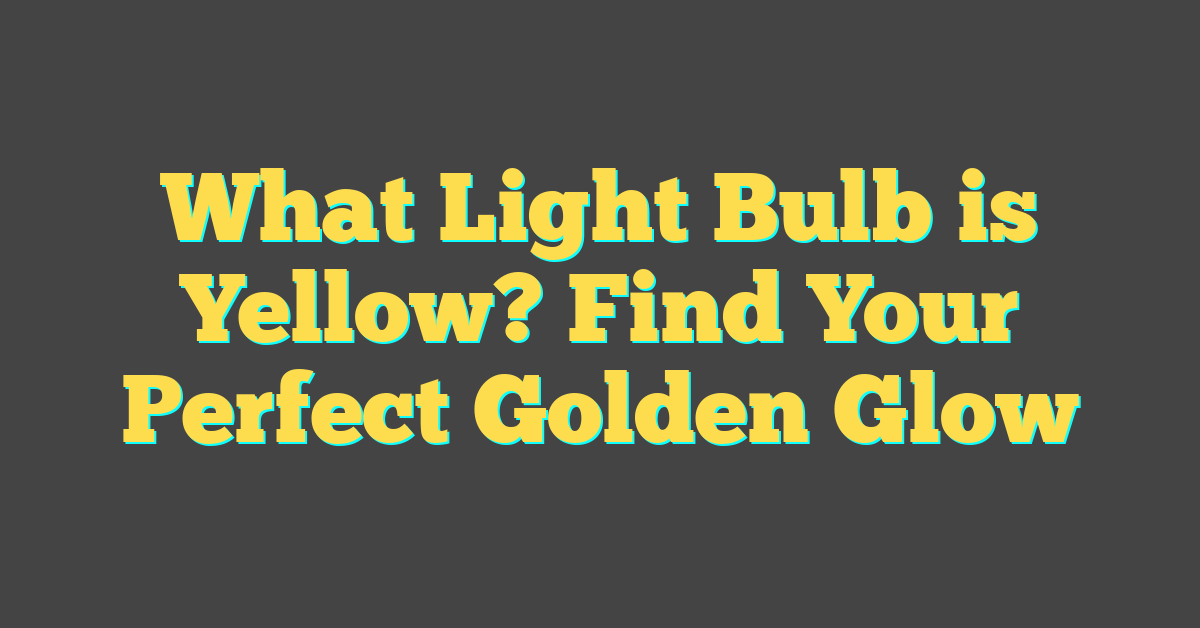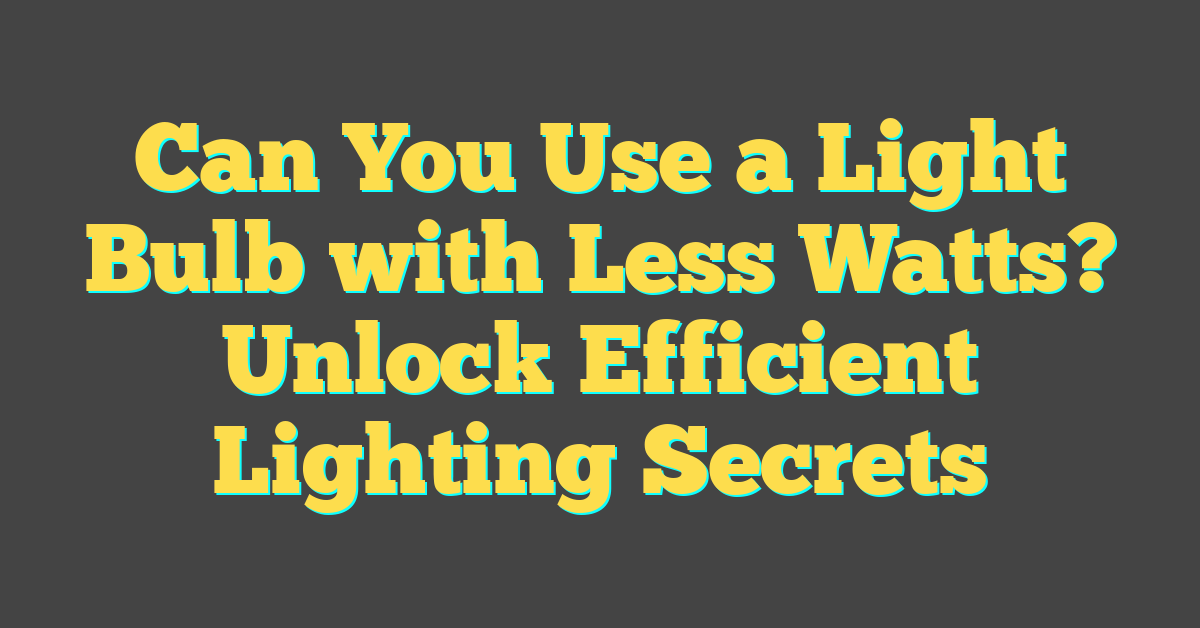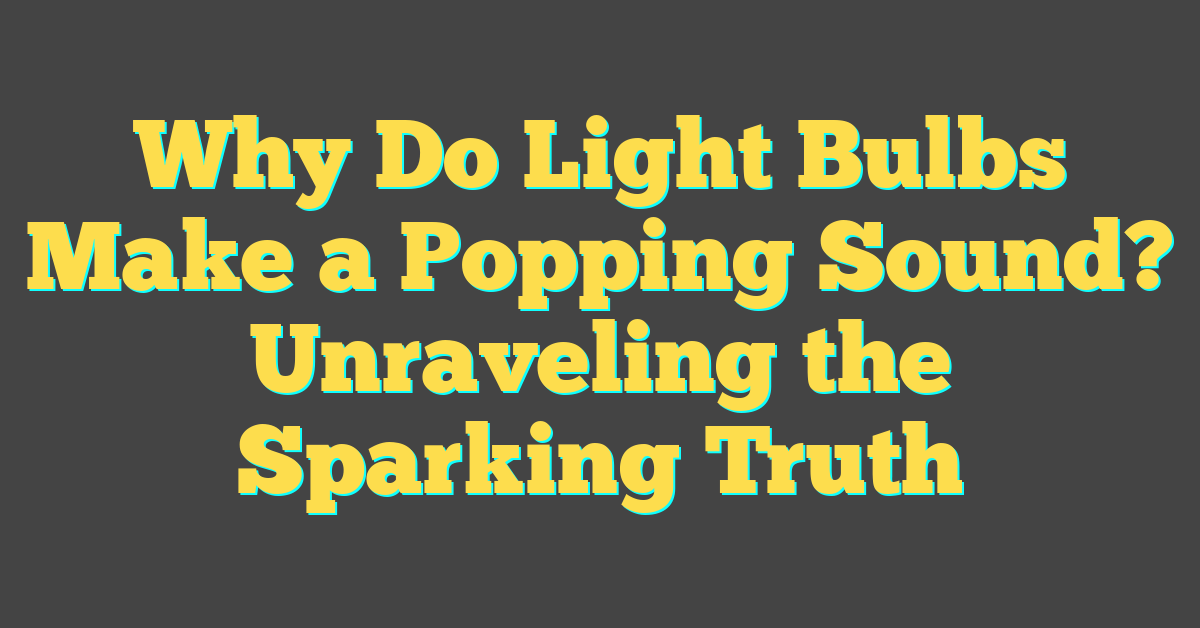Ever found yourself squinting under the harsh glow of a white light bulb, longing for something warmer? You’re not alone. That cozy, inviting ambiance you’re after is often cast by a yellow light bulb, a favorite for creating a relaxed and comforting atmosphere in homes and spaces alike.

But what exactly makes a light bulb emit that golden hue that’s so easy on the eyes? It’s not just about the color of the glass; it’s the light inside that counts. Stick around as we illuminate the ins and outs of yellow light bulbs, ensuring you can pick the perfect glow for your nook every time.
What is a Yellow Light Bulb?
You’ve seen them warm the corners of cafes and exude a gentle glow in your friend’s living room. But when you think of a yellow light bulb, what exactly are you picturing? It’s not just about the color; it’s about the bulb’s ability to tap into a spectrum of light that feels like the setting sun resting on your shoulders.
Technically speaking, yellow light bulbs are often categorized by their color temperature—a feature describing the light’s hue on a Kelvin scale. Typically, yellow light falls between 2700K and 3000K, emanating a warm white reminiscent of early dawn or dusk. This temperature range is ideal for creating a relaxed, inviting ambiance where you’ll want to linger with a book or huddle around a board game.
When it comes to the bulb’s anatomy, yellow light bulbs can come in various forms: LED, incandescent, or halogen. Each type has its characteristics:
- LEDs offer long-lasting performance and energy efficiency with a broad range of color temperatures, including the coveted yellow.
- Incandescent bulbs, the traditional choice, naturally lean towards a warmer hue and provide that classic glow many of us are drawn to.
- Halogen bulbs produce a bright, white light that can be adjusted to cast a yellowish hue when needed.
Choosing the right type depends on your personal preferences and the vibe you’re aiming for in your DIY project. Think about the desired intensity, energy consumption, and how the light plays with other elements in your space. Are you looking for that vintage filament design? Or perhaps a smart bulb that shifts color with the tap of an app?
Regardless of your choice, the right yellow light bulb can transform the mundane into the magical. Consider what your room is asking for—is it the soft whisper of amber or the cheerful chatter of golden beams? Your yellow light bulb is not just a functional object; it’s a mood, a statement, and a silent partner in your home’s story.
Understanding the Color Rendering Index (CRI)

CRI is a pivotal metric that illuminates how true the colors of objects appear under different light sources compared to natural light. The index is measured on a scale from 0 to 100, with natural outdoor sunlight setting the benchmark at 100. In essence, the closer a light bulb’s CRI is to 100, the more vibrant and true colors will look in your home.
When browsing for the perfect yellow light bulb, you’ll want to take CRI into account. A light bulb with a high CRI can make a world of difference in spaces where hue perception is critical — like in your kitchen, where the freshness of food should look inviting, or in your home office, where accurate color discrimination is essential.
Here are the typical CRI ranges you’ll come across:
- 85+ indicates very good color rendering
- 90+ is excellent and often sought after for tasks requiring the most accurate color differentiation
Despite these ranges, a common misconception is that CRI alone defines the color quality of light. Remember, CRI does not describe the color of the light emitted; that’s the role of color temperature. A yellow light bulb could have different CRI values, but its purpose is to emit a warm, cozy glow, typically with a color temperature of around 2700K.
When you’re on the hunt for that mood-setting element in your home, don’t just focus on the light’s color temperature. Give CRI the attention it deserves. Setting up a room with a high-CRI yellow light bulb could very well enhance the overall aesthetics and comfort of your space. After all, isn’t it all about creating an environment where you can relax and feel at ease?
Keep your eyes peeled for the CRI labels as you consider your lighting options. It’s an extra step that can take your home environment from pleasant to visually stunning.
Different Types of Yellow Light Bulbs

« Can You Put LED Light Bulbs in Any Fixture? Avoid These Common Mistakes
How to Use Rechargeable Light Bulbs: Tips for Longevity & Performance »
When you’re on the hunt for that perfect glow, knowing the varieties of yellow light bulbs at your disposal can make all the difference. They’re not all created equal, and each type brings its own charm and functional edge to your living spaces.
First up, let’s talk LED yellow bulbs. These are the go-to for energy savings and longevity. Don’t be fooled by their upfront cost; they’ll save you bucks in the long run with their impressive lifespan. Plus, they’re often dimmable, letting you tweak the ambiance to your heart’s desire.
Next, consider the classic incandescent yellow bulbs. They’re the old-school types your grandparents swore by and they pour out a warm, inviting light akin to a cozy campfire. Perfect for adding a dash of nostalgia to your modern abode, but remember, they do tend to have a shorter life and aren’t the most energy-efficient choice around.
And you can’t overlook halogen bulbs. Often touted for their bright, crisp light, when they’re in the yellow range, they offer a clean look without going full-on sunshine bright. Great for task lighting or areas where clarity under warm light is key.
While you’re picturing your space bathed in yellow tones, let’s not forget compact fluorescent lamps (CFLs). These curly bulbs have come a long way, and some are tailored to give off a less intense yellow light. They balance energy efficiency with a softer glow—think of it as LED’s laid-back cousin.
Each bulb type has its placement sweet spot:
- LEDs excel in virtually any context thanks to their versatility.
- Incandescents are ideal for ambiance where you’re not overly concerned about energy consumption.
- Halogens shine in work areas or spaces where detail is everything.
- CFLs fit nicely in spots where you want energy efficiency and softer lighting.
Choosing the right yellow light bulb is a bit like picking the right tools for a DIY project—you’ll want to match the tool to the job. Ensure you consider not only the type but also the color temperature and CRI. Illuminate your space with purpose and watch as the right yellow light bulb elevates it from mere living quarters to a personalized retreat.
Pros and Cons of Yellow Light Bulbs

When you’re looking to give your home a warm and cozy vibe, yellow light bulbs are often your go-to choice. Their inviting glow can work wonders for creating a relaxing atmosphere in any space. But as with anything, they come with their own set of advantages and drawbacks.
Advantages of Yellow Light Bulbs
- Warm Ambience: Yellow bulbs produce a warm light reminiscent of a sunset, making them perfect for bedrooms, living rooms, or any area where you’d like a sense of comfort.
- Reduced Eye Strain: The soft hue is less harsh on the eyes compared to the stark brightness of cool-white bulbs, ideal for a night-time read.
- Bug Repellent: Insects are less attracted to yellow light, so they’re a smart choice for outdoor fixtures or near entryways to keep pesky critters at bay.
- Color Distortion: Yellow lighting can alter the appearance of colors, not always suitable for areas where color accuracy is key, like bathrooms or closets.
- Energy Efficiency: While LED yellow bulbs are available, traditional yellow-tinted incandescent bulbs don’t match the energy savings of their white LED counterparts.
- Mood Influence: The color of light can affect moods and energy levels; yellow might be too relaxing in places where concentration or alertness is required, such as home offices or kitchens.
As you consider the pros and cons, remember to weigh them against your specific needs for each room in your home. Whether you’re crafting a DIY project or meticulously choosing lighting for a new reading nook, the type of yellow bulb you select can make a significant difference in the look and feel of your space. Keep in mind the bulb’s application, energy consumption, and the effect it’ll have on your overall mood and décor.
Tips for Choosing the Right Yellow Light Bulb

When you’re in the hunt for the ideal yellow light bulb to warm up your space, you’ve got to consider more than just the hue. It’s like picking the perfect accessory for your favorite outfit – it’s gotta match!
Know the Space You’re Illuminating
First off, think about the room where the bulb will shine. Is it a cozy reading nook or a bustling kitchen? Remember, yellow light’s great for chill vibes but not the best for color accuracy or tasks that need your undivided attention.
- Lumens are Key
While wattage used to be the go-to for gauging brightness, lumens are where it’s at now. The higher the lumens, the brighter the light. For a soft glow, you don’t need as many lumens, but for larger areas, you’ll want that higher number. - Color Temperature Matters
Color temperature is measured in Kelvins (K), and for that golden yellow glow, aim for bulbs around 2700K to 3000K. This range hits the sweet spot of warm and inviting light without tipping into the amber territory.
Energy Efficiency is a Must
These days, there’s no excuse not to be eco-conscious. LEDs may cost a bit more upfront, but they’re a champ in energy efficiency and longevity – plus, they come in yellow tones! They’ll save you cash in the long run and you’re doing the planet a solid.
- Dimmable Options for Versatility
If you want to dial the ambiance up or down, go for a dimmable yellow bulb. It gives you the power to adjust the mood from “energetic morning” to “relaxed evening” with a simple slide or tap.
When to Replace Your Bulbs
Don’t wait for the flicker or the fade. If you’ve had your bulbs for a good while, and they’re not LEDs, they’re probably not as efficient or vibrant as they used to be. New bulbs mean fresher light, and who doesn’t love a bright start?
Conclusion
So you’ve got all the insights on picking the perfect yellow light bulb to create that warm, inviting atmosphere you’re after. Remember, it’s all about matching the bulb to your space and needs—whether you’re setting the mood in your living room or adding a splash of coziness to your kitchen. Keep those lumens in mind for the right brightness, stick to the sweet spot of color temperature, and go for LEDs to save on energy. And don’t forget, a dimmable option can really amp up the ambiance. Now, with all this knowledge, you’re ready to light up your world with just the right hue of yellow. Happy lighting!
Frequently Asked Questions
What should I consider when choosing a yellow light bulb for a room?
When choosing a yellow light bulb, consider the room’s purpose to ensure it complements the space. For a cozy atmosphere, like a reading nook, go for a softer yellow light. In busy areas like kitchens, a brighter yellow may be preferable.
How important are lumens when selecting a yellow light bulb?
Lumens are crucial as they measure the bulb’s brightness. Choose a bulb with sufficient lumens to adequately illuminate the space. The higher the lumens, the brighter the light.
What is the ideal color temperature for a yellow light bulb to achieve a golden glow?
For a golden yellow glow, select a yellow light bulb with a color temperature ranging from 2700K to 3000K. This range provides a warm and inviting light.
Are LED yellow bulbs more energy-efficient than other types?
Yes, LED yellow bulbs are more energy-efficient compared to traditional bulbs. They consume less power and have a longer lifespan, making them a cost-effective and eco-friendly choice.
Why should I choose a dimmable yellow light bulb?
Opting for a dimmable yellow light bulb offers versatility, allowing you to adjust the brightness to suit different moods and activities within the room.




